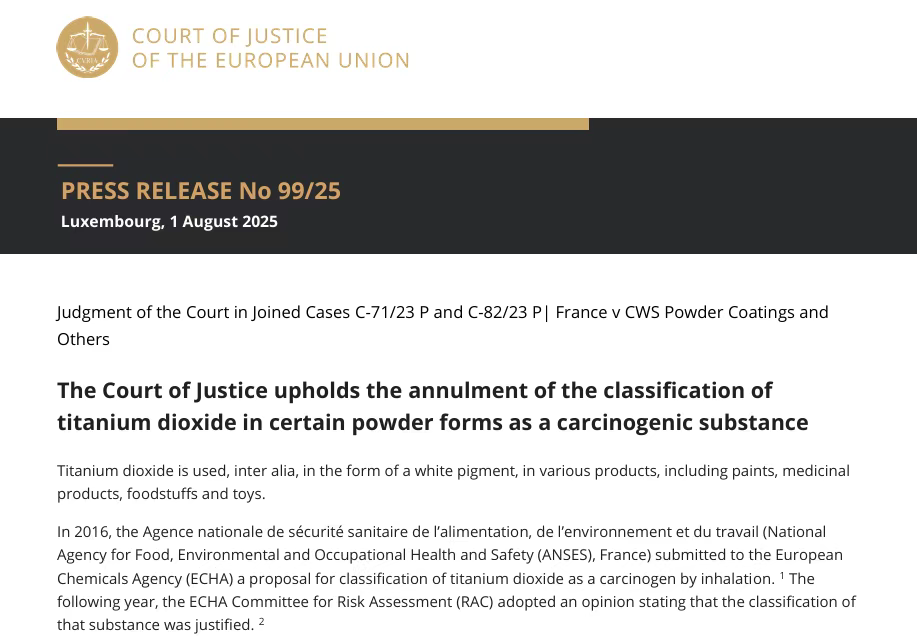Titanium Dioxide "Carcinogenic" Label Removed, European Union Court Upholds Original Ruling

The latest news shows that the EU court has rejected the appeals of France and the European Commission, confirming the cancellation of the classification of certain powdered forms of titanium dioxide (TiO₂).2Classification of substances suspected to be carcinogenic by inhalation.
The European Union Court ultimately ruled to remove specific powder form TiO.2Classification of carcinogenic substances—this ruling will have a profound impact on coating formulations and regulatory compliance in the EU region.
As the most widely used white pigment in industries such as coatings, plastics, cosmetics, and pharmaceuticals, titanium dioxide has experienced a tumultuous fate. In 2016, the French Agency for Food, Environmental and Occupational Health & Safety (ANSES) first proposed classifying it as a carcinogen by inhalation. In 2017, the Risk Assessment Committee (RAC) of the European Chemicals Agency supported this classification. In 2019, the European Commission adopted an authorization regulation classifying powder forms containing 1% or more particles ≤10 micrometers as a Category 2 carcinogen (H351: "Suspected of causing cancer by inhalation").
The regulation was jointly challenged by multiple manufacturers, importers, and downstream users, accusing it of having flawed scientific basis. In November 2022, the General Court of the European Union annulled the classification on the grounds that there were manifest errors in the evaluation of the key scientific studies supporting the regulation. On August 1, 2025, the Court of Justice of the European Union dismissed the appeals filed by France and the European Commission. Although it noted that the General Court had partially exceeded its judicial competence in its review, it confirmed that the RAC had indeed failed to fully consider all relevant factors in assessing the core scientific evidence.
Industry Impact
Industry response
"This ruling is of decisive significance—if the use of or mandatory labeling of the carcinogenic properties of this key raw material is enforced, it will trigger a 'tsunami effect' across numerous raw material sectors. Its impact concerns not only the field of chemical raw materials, but will also reshape the entire judicial system of the EU."
【Copyright and Disclaimer】The above information is collected and organized by PlastMatch. The copyright belongs to the original author. This article is reprinted for the purpose of providing more information, and it does not imply that PlastMatch endorses the views expressed in the article or guarantees its accuracy. If there are any errors in the source attribution or if your legitimate rights have been infringed, please contact us, and we will promptly correct or remove the content. If other media, websites, or individuals use the aforementioned content, they must clearly indicate the original source and origin of the work and assume legal responsibility on their own.
Most Popular
-

List Released! Mexico Announces 50% Tariff On 1,371 China Product Categories
-

EU Changes ELV Regulation Again: Recycled Plastic Content Dispute and Exclusion of Bio-Based Plastics
-

Clariant Unveils Cost-Cutting Plan Details, Plans to Shut Down Multiple Plants
-

Mexico officially imposes tariffs on 1,400 chinese products, with rates up to 50%
-

Nissan Cuts Production of New Leaf EV in Half Due to Battery Shortage






